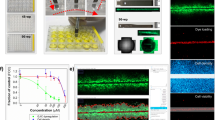Summary
Cell-to-cell communication via gap junctions has played a fundamental role in the orderly development of multicellular organisms. Current methods for measuring this function apply mostly to homotypic cell populations. The newly introduced Fluorescence Activated Cell Sorting (FACS) method, albeit with some limitations, is simple, reliable, and quantitative in measuring the dye transfer via gap junctions in both homotypic and heterotypic cell populations. In the homotypic setting, the result in dye transfer from the FACS method is comparable to the scrape-loading and microinjection methods. Using this FACS method, we observed a decline of cell-to-cell communication in transformed and cancer cells. We also observed a differential degree of communication between two heterotypic cell populations depending on the direction of dye transfer.
Similar content being viewed by others
References
Atkinson, M. M.; Sheridan, J. D. Altered junctional permeability between cells transformed by v-ras, v-mos, or v-src. Am. J. Physiol. 255:C674-C683; 1988.
Chomczynski, P.; Sacchi, N. Single-step method of RNA isolation by guanidinium thiocyanate-phenol chloroform extraction. Anal. Biochem. 162:156–159; 1987.
Dookwah, H. D.; Barhoumi, R.; Narasimhan, T. R., et al. Gap junctions in myometrial cell cultures: evidence for modulation by cyclic adenosine 3′:5′-monophosphate. Biol. Reprod. 47:397–407; 1992.
El-Fouly, M. H.; Troski, J. E.; Chang, C.-C. Scrape-loading and dye transfer: a rapid and simple technique to study gap junctional intercellular communication. Exp. Cell Res. 168:422–430; 1987.
El-Sabban, M. E.; Pauli, B. U. Cytoplasmic dye transfer between meta-static tumor cells and vascular endothelium. J. Cell Biol. 115:1375–1382; 1991.
Fentiman, I. S.; Hurst, J.; Ceriani, R. L., et al. Junctional intercellular communication pattern of cultured human breast cancer cells. Cancer Res. 39:4739–4743; 1979.
Harris, H.; Miller, O. J.; Klein, G., et al. Suppression of malignancy by cell fusion. Nature 223:363–368; 1969.
Kiang, D. T.; King, M.; Zhang, H.-J., et al. Cyclic biological expression in mouse mammary tumors. Science 216:68–70; 1982.
Kiang, D. T.; Atkinson, M. M.; Lin, H. H., et al. Role of cyclic-AMP in modulating gap-junction function in a mouse mammary tumor model. Proc. Am. Assoc. Cancer Res. 34:247; 1993.
Loewenstein, W. R. Junctional intercellular communication and the control of growth. Biochim. Biophys. Acta 560:1–65; 1979.
Mehta, P. P.; Hotz-Wagenblatt, A.; Rose, B., et al. Incorporation of the gene for a cell-cell channel protein into transformed cells leads to normalization of growth. J. Membr. Biol. 124:207–225; 1991.
Mehta, P. P.; Loewenstein, W. R. Differential regulation of communication by retinoic acid in homologous and heterologous junctions between normal and transformed cells. J. Cell Biol. 113:371–379; 1991.
Nicolson, G. L.; Dulski, K. M.; Trosko, J. E. Loss of intercellular junctional communication correlates with metastatic potential in mammary adenocarcinoma cells. Proc. Natl. Acad. Sci. USA 85:473–476; 1988.
Rogers, M.; Berestecky, J.; Hossain, M. Z., et al. Retinoid-enhanced gap junctional communication is achieved by increased levels of connexin43 mRNA and protein. Mol. Carcinog. 3:335–343; 1990.
Roseng, L. E.; Rivedal, E.; Sanner, T. Effect of cAMP elevating compounds on inhibition of gap junctional communication and induction of morphological transformation in Syrian hamster embryo cells. Carcinogenesis 13:1803–1809; 1992.
Tlsty, T. D.; White, A.; Sanchez, J. Suppression of gene amplification in human cell hybrids. Science 255:1425–1427; 1992.
Tomasetto, C.; Neveu, M. J.; Daley, J., et al. Specificity of gap junction communication among human mammary cells and connexin transfectants in culture. J. Cell Biol. 122:157–167; 1993.
Wade, M. H.; Trosko, J. E.; Schindler, M. A fluorescence photo-bleaching assay of gap junction-mediated communication between human cells. Science 232:429–552; 1986.
Yamasaki, H.; Hollstein, M.; Mesnil, M., et al. Selective lack of intercellular communication between transformed and nontransformed cells as a common property of chemical and oncogene transformation of BALB/c 3T3 cells. Cancer Res. 47:5658–5664; 1987.
Yamasaki, H.; Katoh, F. Further evidence for the involvement of gap-junctional intercellular communication in induction and maintenance of transformed foci in BALB/c 3T3 cells. Cancer Res. 48:3490–3495; 1988.
Zajchowski, D. A.; Band, V.; Trask, D. K., et al. Suppression of tumor-forming ability and related traits in MCF-7 human breast cancer cells by fusion with immortal mammary epithelial cells. Proc. Natl. Acad. Sci. USA 87:2314–2318; 1990.
Zhang, L.-X.; Cooney, R. V.; Bertram, J. S. Carotenoids enhance gap junctional communication and inhibit lipid peroxidation in C3H/10T1/2 cells: relationship to their cancer chemopreventive action. Carcinogenesis 12:2109–2114; 1991.
Zhu, D.; Caveney, S.; Kidder, G. M., et al. Transfection of C6 glioma cells with connexin 43 cDNA: analysis of expression, intercellular coupling, and cell proliferation. Proc. Natl. Acad. Sci. USA 88:1883–1887; 1991.
Author information
Authors and Affiliations
Rights and permissions
About this article
Cite this article
Kiang, D.T., Kollander, R., Lin, H.H. et al. Measurement of gap junctional communication by fluorescence activated cell sorting. In Vitro Cell Dev Biol - Animal 30, 796–802 (1994). https://doi.org/10.1007/BF02631304
Received:
Accepted:
Issue Date:
DOI: https://doi.org/10.1007/BF02631304



